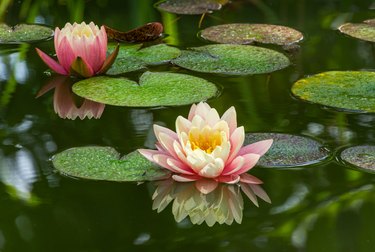
When you're bringing in plants to make your landscape more beautiful, there's no reason to ignore the backyard pond. The most popular flowers for ponds are water lilies, a floating aquatic plant with large, fragrant blossoms and round, floating leaves. These remarkable plants have developed distinctive features and functions to allow them to live with their blossoms on the water surface and their roots far below in the soil beneath.
Meet the Water Lily
Video of the Day
You may have seen the famous series of paintings by Claude Monet that feature the water lilies in a pond on his property in France. He painted them not once but some 250 times, but who can fault him? There's something about the fragile beauty of the blossom and the incredible resilience of the plant structure that has a deep and abiding appeal.
Video of the Day
Water lily is the common name given to plants in the family Nymphaeaceae, particularly in the genus Nymphaea, meaning water nymph. They feature floating white or pink flowers that are 2 to 6 inches across and very fragrant. Each blossom has four sepals and dozens of rows of white petals with some 70 stamens. The flowers each have a stem that anchors it to the roots. Many water lilies open only in the morning, while others open only in the evening, and they live for about five days.
Inspect Water Lily Leaves
The round, flat leaves (aka lily pads) are as much a characteristic of the plants as the flowers themselves. The leaves — up to 10 inches across — float on the surface of the water, a bright shade of green above and reddish-purple below. They have natural, narrow cuts that go almost to the center point where the leaf stem is attached. Like land plant leaves, the primary job of water lily leaves is photosynthesis: transforming sunlight into energy for the plant.
The surface of the leaf has tiny openings called stomata through which gasses pass into the plant. While land-based plants also have stomata, they're located on the lower surface of the leaf. The stomata of water lily leaves are located on the upper, shiny leaf surface. They're protected by a waxy, waterproof layer called the cuticle.
Consider the Leaf Stalk
The leaf stalk of the water lily is quite different than leaf stalks of dry-land plants. These water-based leaf stalks are soft and spongy to allow them to float easily in a pond. However, they're tough enough not to be broken by rough currents. Each stalk has four primary air channels that allow for gasses to travel from the stomata on the leaves to the thick roots, termed rhizomes, that are buried in the dirt at the bottom of the pond.
As recognizable as the lily flower are the leaves that surround it. Water lily leaves, called lily pads, are thick and buoyant leaves that float along the surface of the water close to the water lily. Lily pads do the same work as leaves on land plants, gathering sunlight for the plant to continue photosynthesis and exchanging gases. Water lily leaves are thicker than other leaves and consume a large area, sometimes larger than the flower itself. This helps lily pads stay above water even when frogs hop onto them.